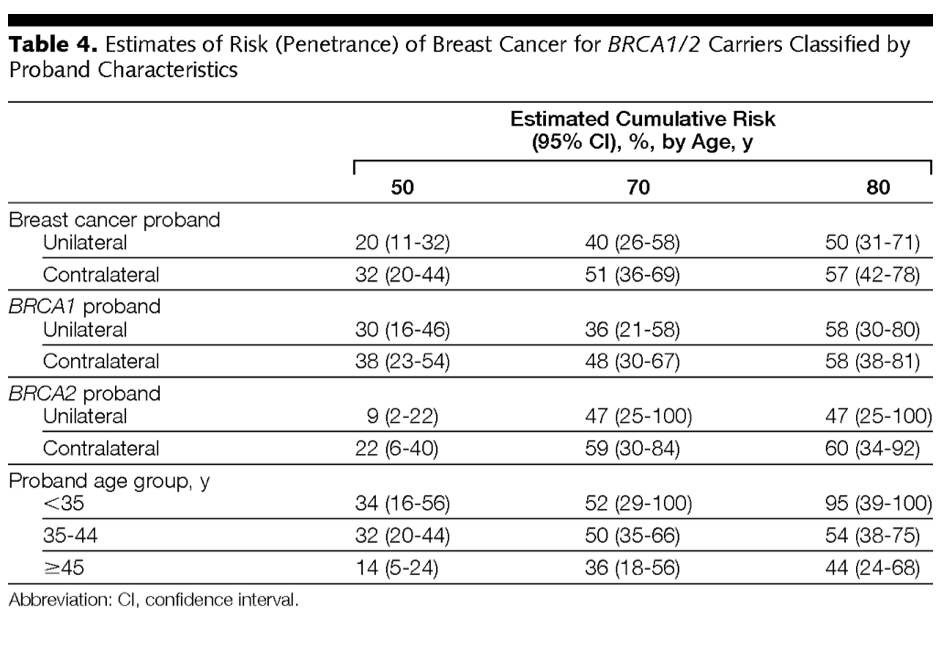This web page was produced as an assignment for an undergraduate course at Davidson College.
Do BRCA 1 and 2 Predict Cancer Risk?
Background Information on BRCA
BRCA 1 and 2 are tumor suppressor genes that are frequently mutated in breast and ovarian cancers. The mutation is inheritable and increases ones risk of developing cancer. BRCA1 is found on chromosome 17 and BRCA2 is found on chromosome 13.
BRCA1

UCSC Genome Browser, Permission Pending
BRCA2

UCSC Genome Browser, Permission Pending
Since its discovery in 1994, many studies have been conducted to predict carrier’s chance of developing breast or ovarian cancer. A New York Times article published in 1995, states that if you inherit the BRCA gene your chance of being diagnosed with cancer is 90%. Recent studies suggest that the risk is actually much less, but is very variable.
Journal Article
Set up:
On January 9th, 2008, researchers at Memorial Sloan Kettering Cancer published a paper in JAMA suggesting that the risk of breast cancer can vary widely among BRCA carriers. The study analyzed the BRCA 1 and 2 genes of about 2,000 women who were diagnosed with breast cancer before the age of 55. These women were split into two populations: women with contralateral breast cancer and women with unilateral breast cancer. Unilateral breast cancer signifies that a tumor is present in one breast, where as contralateral breast cancer means that a patient had a tumor in her breast, underwent surgery and then was diagnosed with a tumor in the other breast at least a year later. The researchers also collected information about cancer prevalence in primary relatives (mothers, sisters and daughters).
Methods:
The researchers sequenced the BRCA 1 and 2 genes for each of these women to identify any mutations. They calculated the prevalence of breast cancer the first-degree relatives of the patients with and without mutations. From this information, the researchers mathematically modeled their estimated risk for family members of BRCA carriers, taking a wide variety of factors into account. The covariates included: whether the patient had contralateral or unilateral breast cancer, age at diagnosis, the geographical region of the patient, the location of the mutation on the BRCA genes, and a random effect was included to compensate for individual risk variation.
Results:

Permission Pending
Conclusion: Risk of inherited breast cancer is less than previously predicted, but random factors can cause a high degree of variability.
Popular Press Article
Tara Parker-Pope reports on this paper in a New York Times publication on January 8th 2008. According to Kua et al., 2004, scientific journalism articles should contain three key elements: a context of relevant scientific research, the methods used, and the relevance of the discovery. Parker-Pope effectively describes the relevance of the study but glosses over the relevant scientific research as well as the methods and set up of the study.
Parker-Pope begins her piece with a summary of the findings of this study and implicitly describes what BRCA genes are, but does not give relevant background on other studies that have been conducted. The statistic that she quotes from the American Society of Breast Surgeons illustrates a differing view, but does not give good insight into the scientific process and how different labs can reach varying conclusions based on how their studies are set up.
My main problem with the article is the lack of precision she uses in explaining the study. She does not explain the setup of the study and differentiate between the two populations of women. She says the study encompasses 2,000 women, but does not separate the unilateral and contralateral patients analyzed. Furthermore, the statistics she cites are not directly comparable based on the way they are presented in the journal article. Parker-Pope states, “researchers at the Memorial Sloan-Kettering Cancer Center have found that a carrier’s risk of developing breast cancer by age 70 ranges from 36 percent to 52 percent” (Parker-Pope, 2008). According to the journal article, BRCA1 carriers who are related to patients with unilateral breast cancer have an estimated 36% risk by age 70. If she wanted to demonstrate the range of risk she could compare that population to the BRCA2 unilateral population, or compare both unilateral and contralateral populations with both mutations. Instead, she compares the BRCA1, unilateral carrier population to the estimated risk of a carrier whose relative was diagnosed by age 35. This 52% estimated risk includes both BRCA 1 and 2 mutations and both contralateral and unilateral populations. In the following paragraph, though, she does do a much better job of explaining how age of diagnosis of the carrier’s relative affects their risk of developing breast cancer. Finally, throughout the paper she consistently states that the scientists “found” the risk of relatives, meanwhile in the original article is very clear that they modeled these predictions and use the words “estimate of risk”.
Parker-Pope ends the article strongly by discussing the implications of this study and compares the risk estimated by this study for carriers to the 12% lifetime risk of non-carriers. Most importantly, she emphasizes the variability in the risk of developing cancer, even if you are a carrier. She closes her article with a quote from the lead author, Dr. Begg, who states that the purpose of the study is to help patients understand the risks so they can make the best decision.
References
Begg, Colin, et. al. 2008. Variation of Breast Cancer Risk Among BRCA1/2 Carriers. JAMA. 299: 194-201. Acessed 23 Jan 2013. <http://jama.jamanetwork.com/article.aspx?articleid=1149366>
Kolata, Gina. "Research Links Single Gene to Almost All Breast Cancers". The New York Times. 03 Nov. 1995. Accessed 30 Jan. 2013. <http://www.nytimes.com/1995/11/03/us/research-links-single-gene-to-almost-all-breast-cancers.html>
Kua, E., Reder, M., and Grossel, M.J.. 2004. Science in the News: A Study of Reporting Genomics. Public Understanding of Science. 13: 309–322.
Parker-Pope, Tara. "Breast Cancer Gene Risk May Be Over Stated". The New York Times Well Blog. 08 Jan. 2008. Accessed 23 Jan 2013. <http://well.blogs.nytimes.com/2008/01/08/breast-cancer-gene-risk-may-be-overstated/>
Anja's Home Page
Genomics Website


